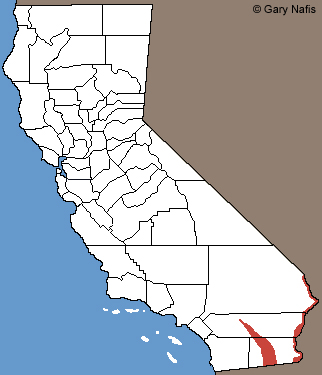|
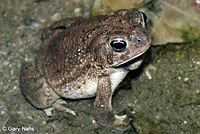 |
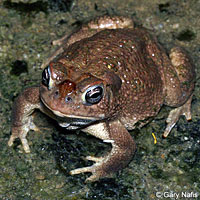 |
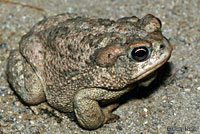 |
| Adult, Riverside County |
Adult, Riverside County |
Adult, Riverside County |
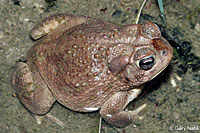 |
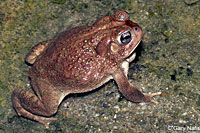 |
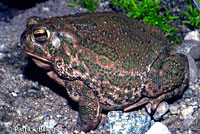 |
| Adult, Riverside County |
Adult, Riverside County |
Adult, Imperial County
© Patrick Briggs |
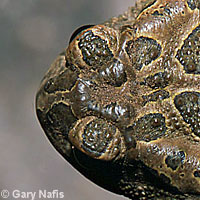 |
 |
 |
| Cranial crests converge at the front. |
Comparison of Anaxyrus cognatus on right and Anaxyrus woodhousii on left.
The cranial crests of A. cognatus point inward at the front, often coming together.
The parotoid glands of A. woodhousii are more elongated than on A. cognatus.
|
| Breeding Adults |
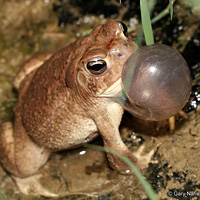 |
 |
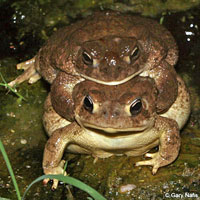 |
| Calling adult male, Riverside County |
Calling adult male, Riverside County |
Male and female in amplexus,
Riverside County |
| |
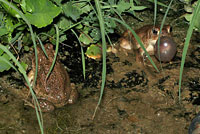 |
|
| |
Calling males, Riverside County
|
|
| |
|
|
| Great Plains Toads From Outside California |
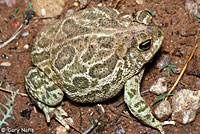 |
 |
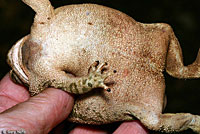 |
| |
Adult, Cochise County, Arizona |
|
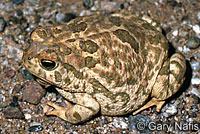 |
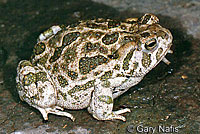 |
|
Adult, Cochise County, Arizona
|
Adult, New Mexico |
|
| |
|
|
| Great Plains Toad Habitat in California |
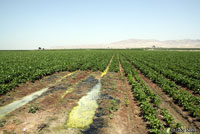 |
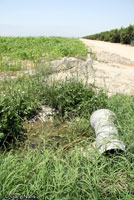 |
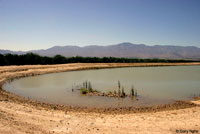 |
| Breeding habitat, edge of irrigated field, Riverside County |
Breeding habitat, edge of irrigated field, Riverside County |
Habitat, agricultural irrigation pond, Riverside County |
| |
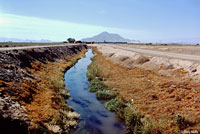 |
|
| |
Irrigation canal habitat,
Imperial County
|
|
| |
|
|
| Short Video |
| |
 |
|
| |
Two male toads calling at night in Riverside County.
|
|
| |
|
|
|
Description |
| |
| Size |
Adults are 2 - 4.5 inches from snout to vent ( 4.6 - 11.4 cm).(Stebbins & McGinnis, 2012)
|
| Appearance |
A large and robust toad with dry, warty skin.
Cranial crests form a boss on snout and separate widely toward the rear of the head.
A sharp tubercle is found on each hind foot.
Parotoid glands are elongated.
Pupils are horizontal. |
| Color and Pattern |
Light brown, gray, or olive above with large, symmetrical olive, or green blotches with light borders.
May have a thin stripe along the middle of the back.
Pale whitish below usually with no spots. |
| Young |
| Young have many small red tubercles and a v-shaped crest. |
| Larvae (Tadpoles) |
About 1 inch in total length (2.5 cm.) Beginning black in color, they gradually lighten up to a mottled gray or brown or black color.
|
| Life History and Behavior |
| Activity |
Adults are nocturnal. Juveniles are diurnal.
A good burrower, this toad remains underground in the daytime burrowed into loose soil.
Sometimes seen out during daylight on cloudy, rainy days.
|
| Hibernation and Estivation |
| To escape winter freezes, toads burrow below the frostline. In California, they probably don't need to burrow so deep. Toads remain underground during periods of prolonged cold and heat - which can be as much as 63 - 77 percent of the year (Ewert, 1969 cited by Graves and Krupa in Lanoo 2005.) Heavy spring rain triggers emergence. |
| Movement |
| A typical toad: slow moving, often using a walking or crawling motion along with short hops. |
| Defense |
| For defense, like most toads, this toad relies on parotoid glands and warts which can secrete a poison that deters some predators. They have also been observed inflating the body to avoid predation by hog-nosed snakes. |
| Longevity |
| Long-lived, from 10 to possibly 20 years. |
| Voice (Listen) |
| The call of this toad is an explosive jackhammer-like metallic trill lasting from 5 seconds to almost a minute. It can be almost deafening when heard from a close distance. Calls are made at night. |
| Diet and Feeding |
This toad's diet consists of a variety of invertebrates, including ants, flies, centipedes, mites, and cutworms.
The prey is located by sight, then the toad lunges with a large sticky tongue to catch the prey and bring it into the mouth to eat. |
| Reproduction |
Reproduction is aquatic.
Fertilization is external, with the male grasping the back of the female and releasing sperm as the female lays her eggs.
Reproduction can take place throughout the season and females may lay eggs multiple times in a single year.
Breeding and egg-laying takes place in temporary pools, slow streams, irrigation ditches, holding ponds and flooded fields.
Amplexus is axillary - the male grabs the female around her shoulders or armpits.
The reproductive cycle is similar to that of most North American Frogs and Toads. Reproductive mature adults ( 2 - 5 years old - 2 years in Arizona, and probably the same in California) come into breeding condition and migrate to ponds or ditches where the males call to advertise their fitness to competing males and to females. Males and females pair up in amplexus in the water where the female lays her eggs as the male fertilizes them externally. The adults leave the water and the eggs hatch into tadpoles which feed in the water and eventually grow four legs, lose their tails and emerge onto land where they disperse into the surrounding territory.
Throughout most of the range of this species, toads emerge from burrows after heavy spring rains and move to breeding wetlands, generally from March to September. In the irrigated agricultural lands in the desert where this toad has increased its range in California, breeding is stimulated by flooding from increased crop irrigation or temperature change, since little rain falls in the area. |
| Eggs |
Females lay Eggs are laid in strings of either single or double rows of ova surrounded by transparent jelly.
Egg strings are attached to debris in clear, shallow, water with little current.
According to one expert (Krupa, 1994) egg laying usually begins at dawn and finishes by noon.
27 Oklahoma females that were studied laid from 1,342 - 45,054 eggs, an average of 11,074. (Krupa, 1986a, cited by Graves and Krupa in Lanoo 2005).
Eggs hatch in 2 - 7 days. |
| Tadpoles and Young |
Tadpoles graze on submerged rocks or plants feeding on plant material and decomposing invertebrate remains.
Metamorphosis takes place anywhere from 17 - 45 days after hatching, depending on water temperature and evaporation rates. Survival rate of tadpoles varies from year to year, with few surviving during a bad year.
Newly metamorphosed toads stay near their birth area for about a month or less if it dries up. They then move into agricultural fields where they can burrow into the soil, sometimes forming large aggregations.
|
| Hybrids |
Hybridizes with A. woodhousii and rarely with A. punctatus (and outside of California with A. speciosus and A. hemiophrys.)
|
| Habitat |
Great Plains Toads inhabit creosote bush and mesquite deserts and desert scrub, prairie grasslands, sand hills, sagebrush plains, and agricultural regions, in association with temporary ponds, wetlands, and irrigation ponds and ditches. They are more tolerant of dry conditions than most toad species.
|
| Geographical Range |
In California, Great Plains Toads are found along the Colorado River, the Imperial Valley, and in the Coachella Valley. They most likely spread from the Colorado River into the Imperial Valley as the land was developed for agriculture then they spread into the Coachella Valley as the land was developed for housing and golf courses.
The species ranges throughout the plains states east of the Rockies north into southern Canada, east to the eastern edges of Minnesota, Iowa, and Missouri, into western Texas, New Mexico, Arizona, Utah, Nevada, and into central Mexico.
|
 |
| Elevational Range |
Found below sea level to 8,000 ft. (2,440 m.) in elevation. (Stebbins, 2003)
|
| Notes on Taxonomy |
Formerly included in the genus Bufo. In 2006, Frost et al replaced the long-standing genus Bufo in North America with Anaxyrus, restricting Bufo to the eastern hemisphere. Bufo is still used in most existing references (2014).
Alternate and Previous Names (Synonyms)
Bufo cognatus - Great Plains Toad (Stebbins 1954, 1966, 1985, 2003, Stebbins & McGinnis 2012)
Bufo cognatus - Great Plains Toad (Say's Toad, Western Toad, Plains Toad, Texas Toad, Western Plains Toad) (Wright and Wright 1949)
Bufo cognatus cognatus - Great Plains Toad (Storer 1925)
Bufo cognatus cognatus - Great Plains Toad (Grinnell and Camp 1917)
Bufo cognatus (Say 1823)
|
| Conservation Issues (Conservation Status) |
| None |
|
|
Taxonomy |
| Family |
Bufonidae |
True Toads |
Gray, 1825 |
| Genus |
Anaxyrus |
North American Toads |
Tschudi, 1845 |
| Species |
cognatus |
Great Plains Toad
|
(Say, 1822) |
|
Original Description |
Bufo cognatus Say, 1823 - in James, Long's Exp. Rocky Mts., Vol. 2, p. 190
from Original Description Citations for the Reptiles and Amphibians of North America © Ellin Beltz
|
|
Meaning of the Scientific Name |
Anaxyrus - Greek = A king or chief
cognatus - Latin = related by birth
Taken in part from Scientific and Common Names of the Reptiles and Amphibians of North America - Explained © Ellin Beltz
|
|
Related or Similar California Frogs |
Anaxyrus boreas halophilus
Anaxyrus woodhousii
|
|
More Information and References |
California Department of Fish and Wildlife
AmphibiaWeb
Hansen, Robert W. and Shedd, Jackson D. California Amphibians and Reptiles. (Princeton Field Guides.) Princeton University Press, 2025.
Stebbins, Robert C., and McGinnis, Samuel M. Field Guide to Amphibians and Reptiles of California: Revised Edition (California Natural History Guides) University of California Press, 2012.
Stebbins, Robert C. California Amphibians and Reptiles. The University of California Press, 1972.
Flaxington, William C. Amphibians and Reptiles of California: Field Observations, Distribution, and Natural History. Fieldnotes Press, Anaheim, California, 2021.
Nicholson, K. E. (ed.). 2025. Scientific and Standard English Names of Amphibians and Reptiles of North America North of Mexico, with Comments Regarding Confidence in Our Understanding. Ninth Edition. Society for the Study of Amphibians and Reptiles. [SSAR] 87pp.
Samuel M. McGinnis and Robert C. Stebbins. Peterson Field Guide to Western Reptiles & Amphibians. 4th Edition. Houghton Mifflin Harcourt Publishing Company, 2018.
Stebbins, Robert C. A Field Guide to Western Reptiles and Amphibians. 3rd Edition. Houghton Mifflin Company, 2003.
Behler, John L., and F. Wayne King. The Audubon Society Field Guide to North American Reptiles and Amphibians. Alfred A. Knopf, 1992.
Robert Powell, Roger Conant, and Joseph T. Collins. Peterson Field Guide to Reptiles and Amphibians of Eastern and Central North America. Fourth Edition. Houghton Mifflin Harcourt, 2016.
Powell, Robert., Joseph T. Collins, and Errol D. Hooper Jr. A Key to Amphibians and Reptiles of the Continental United States and Canada. The University Press of Kansas, 1998.
American Museum of Natural History - Amphibian Species of the World 6.2
Bartlett, R. D. & Patricia P. Bartlett. Guide and Reference to the Amphibians of Western North America (North of Mexico) and Hawaii. University Press of Florida, 2009.
Elliott, Lang, Carl Gerhardt, and Carlos Davidson. Frogs and Toads of North America, a Comprehensive Guide to their Identification, Behavior, and Calls. Houghton Mifflin Harcourt, 2009.
Lannoo, Michael (Editor). Amphibian Declines: The Conservation Status of United States Species. University of California Press, June 2005.
Storer, Tracy I. A Synopsis of the Amphibia of California. University of California Press Berkeley, California 1925.
Wright, Albert Hazen and Anna Wright. Handbook of Frogs and Toads of the United States and Canada. Cornell University Press, 1949.
Davidson, Carlos. Booklet to the CD Frog and Toad Calls of the Pacific Coast - Vanishing Voices. Cornell Laboratory of Ornithology, 1995.
Joseph Grinnell and Charles Lewis Camp. A Distributional List of the Amphibians and Reptiles of California. University of California Publications in Zoology Vol. 17, No. 10, pp. 127-208. July 11, 1917.
|
|
|
The following conservation status listings for this animal are taken from the July 2025 State of California Special Animals List and the July 2025 Federally Listed Endangered and Threatened Animals of California list (unless indicated otherwise below.) Both lists are produced by multiple agencies every year, and sometimes more than once per year, so the conservation status listing information found below might not be from the most recent lists, but they don't change a great deal from year to year.. To make sure you are seeing the most recent listings, go to this California Department of Fish and Wildlife web page where you can search for and download both lists:
https://www.wildlife.ca.gov/Data/CNDDB/Plants-and-Animals.
A detailed explanation of the meaning of the status listing symbols can be found at the beginning of the two lists. For quick reference, I have included them on my Special Status Information page.
If no status is listed here, the animal is not included on either list. This most likely indicates that there are no serious conservation concerns for the animal. To find out more about an animal's status you can also go to the NatureServe and IUCN websites to check their rankings.
Check the current California Department of Fish and Wildlife sport fishing regulations to find out if this animal can be legally pursued and handled or collected with possession of a current fishing license. You can also look at the summary of the sport fishing regulations as they apply only to reptiles and amphibians that has been made for this website.
This toad is not on the Special Animals List. There are no significant conservation concerns for it in California.
|
| Organization |
Status Listing |
Notes |
| NatureServe Global Ranking |
|
|
| NatureServe State Ranking |
|
|
| U.S. Endangered Species Act (ESA) |
None |
|
| California Endangered Species Act (CESA) |
None |
|
| California Department of Fish and Wildlife |
None |
|
| Bureau of Land Management |
None |
|
| USDA Forest Service |
None |
|
| IUCN |
|
|
|
|
|
